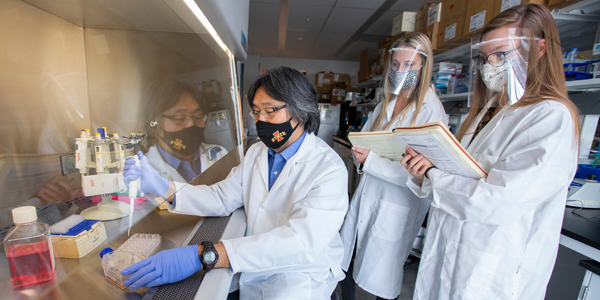
Researchers Respond to COVID-19
TRACKING COVID IMPACTS VIA NEW WEB HUB
A new web hub, “COVID-19 Pandemic: Research and Resources,” developed by the Center for Agricultural and Rural Development and Department of Economics has quickly become an important resource for those seeking insights into the pandemic’s economic and social impacts on agriculture, business, communities and individuals. The site’s growing set of research papers, tables, graphs and maps interpret the pandemic’s influence across local, regional and global economies. There also is an interactive tool to estimate total COVID-19-related losses to Iowa’s corn, soybean and ethanol markets.
SKIPPING MEDICAL LABS? NEW TEST MAY MAKE IT POSSIBLE
A transportable platform resembling a mobile phone could be used to detect the virus that causes COVID-19 — without sending samples away to a medical laboratory. Its creation is the goal of a research team led by Marit Nilsen-Hamilton, professor in biochemistry, biophysics and molecular biology, through her company Aptalogic. “The testing platform could identify viral particles in saliva or blood samples,” says Nilsen-Hamilton. “It even has the potential to detect the virus in the air or on surfaces.” Her partners include Pranav Shrotriya, professor of mechanical engineering at Iowa State, and Wendy Maury, a University of Iowa virologist. Support for the project includes funding from the U.S. Department of Homeland Security for development of an air monitor to detect the SARS-CoV-2 virus (COVID-19) and other biothreats.
EXAMINING COVID’S RURAL IMPACTS
COVID-19’s toll on the health and vitality of Iowa’s rural communities is the focus of research by David Peters, associate professor
of sociology and rural extension sociologist. He’s working with collaborators in sociology, criminology and public health, who want to assure the pandemic’s impact on small towns will not be ignored in academic and policy discussions. “Small towns are too often statistically invisible, creating a false sense of rural immunity, even as they may be faced with rising numbers of cases and deaths,” Peters says. “Without timely social research, policies may fail to address pressing rural needs or be ill-suited to rural contexts.” The team will survey over 15,000 residents across 72 small Iowa towns. Their project received a rapid-response grant from the National Science Foundation in July. Peters also has published a COVID-19 susceptibility scale detailing 11 risk components in the Journal of Rural Health. Find a link to the map of risk scores.
TARGETING COVID RNA TO DEVELOP DRUG THERAPIES
At this point, there is no effective way to cure infection from the SARS-CoV-2 Virus that causes COVID-19. To identify COVID-specific antiviral drugs Iowa State researchers are looking for unique structures within the SARS-CoV-2 virus’ RNA genome that can be exploited to limit its ability to replicate. The team consists of Walter Moss, assistant professor in the Roy J. Carver Department of Biochemistry, Biophysics and Molecular Biology, with Allen Miller, plant pathology and microbiology, and Cathy Miller, veterinary microbiology and preventive medicine. Their main tool is a new method Moss devised with Ryan Andrews, a doctoral candidate, to analyze unusual sequence patterns in viral RNA, such as the types found in Zika, HIV and coronavirus. These patterns form shapes governing how RNAs interact with other molecules, including proteins, that are the basis of drug therapies. Their project recently received seed grant funding from Iowa State’s Office of the Vice President for Research.
NEUTRALIZING COVID WITH UV-A LIGHT TECHNOLOGY
Jacek Koziel, professor of agricultural and biosystems engineering, is leading a team developing a new UV ultraviolet light technology to inactivate airborne viruses like the novel coronavirus. An important benefit of UV-A light is that it is less toxic to people than conventional UV-C light sometimes used as a bactericide. He is testing the technology’s ability to fight the airborne Porcine Reproductive and Respiratory Syndrome (PRRS) virus, a serious threat to swine and potentially related to SARS-CoV-2. Koziel is working on the project with collaborators in veterinary medicine and chemistry. Funders for their project include the National Pork Board.
SCREENING VACCINES AND THERAPIES WITH MODEL “LUNG”
Creating a “lung on a chip” is how Donald Sakaguchi describes his effort to develop a prescreening tool for COVID-19 vaccine or drug candidates before human testing. Sakaguchi, Morrill Professor in genetics, development and cell biology, and colleagues from across campus are designing their “human-relevant, 3-dimensional in-vitro model screening platform” from cultured human respiratory system cells. The innovative model could more accurately mimic the respiratory tract than current screening platforms. The project received seed grant funding from the ISU Office of the Vice President for Research.



